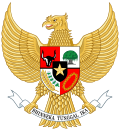Second Hatta Cabinet Kabinet Hatta II | |
|---|---|
| 9th Cabinet of Indonesia | |
| 1949 | |
 | |
| Date formed | 4 August 1949 |
| Date dissolved | 20 December 1949 |
| People and organisations | |
| Head of state | Sukarno |
| Head of government | Mohammad Hatta |
| No. of ministers | 17 ministers |
| Member party | Masyumi PNI Parkindo Catholic Party PIR Independent |
| History | |
| Predecessor | Hatta I Cabinet |
| Successor | |
| ||
|---|---|---|
Pre-independence Domestic policy Foreign policy Family Media and legacy | ||
The Second Hatta Cabinet (Indonesian : Kabinet Hatta II) was Indonesia's ninth cabinet. It was formed after the Indonesian leadership, which had been imprisoned by Dutch forces, returned to the capital, Yogyakarta. It served from 4 August to 20 December 1949.

